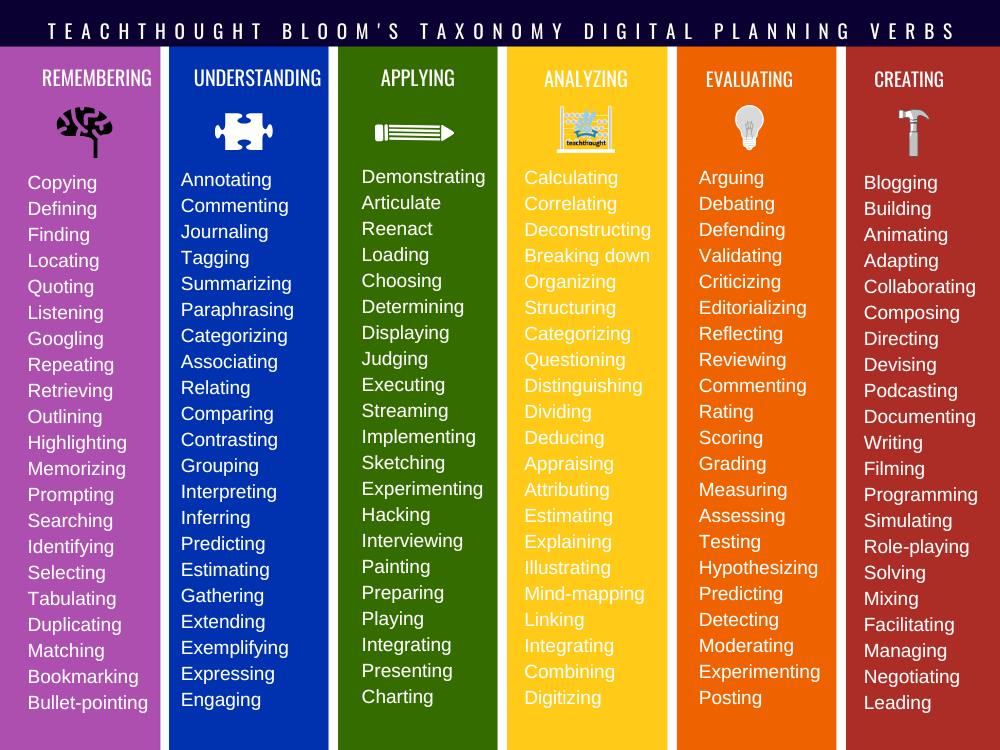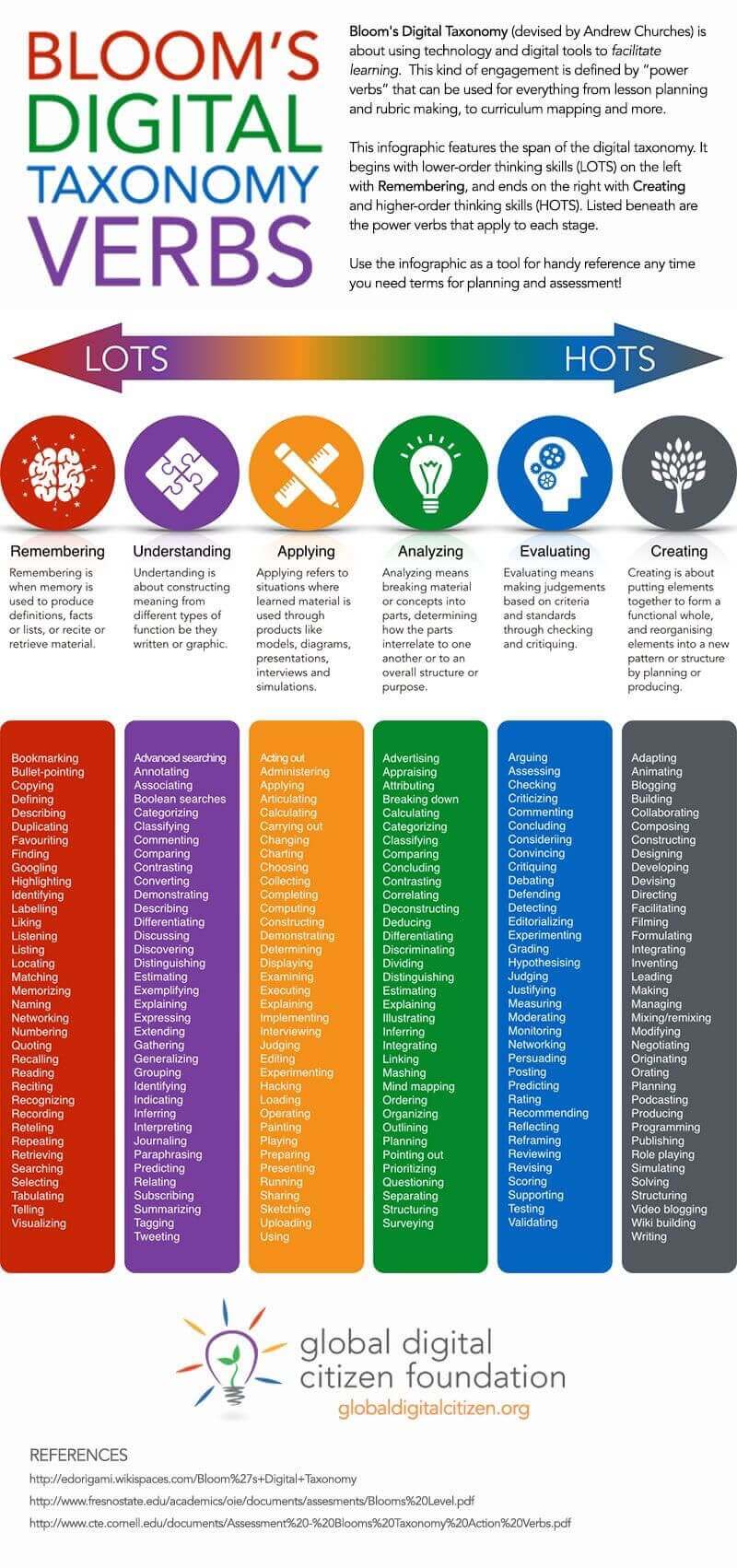by Staff
At Teachthought, we are interested in supporters of any learning taxonomy.
(We have even created ours, the Teaching learning taxonomy.)
Learning taxonomies help us think about how learning occurs, stressing that there are many ways to frame thought.
Bloom’s digital taxonomy verbs adapt Bloom’s original cognitive framework for digital learning, helping teachers from kindergarten to 12th year to integrate technology while strengthening reflection skills. Taxonomy organizes digital levels in levels such as recall, understanding, application, analysis, evaluation and creation, each with technological verbs that support specific learning objectives.
This means that we can have taxonomies for differentiation and taxonomies for thought and taxonomies for tasks and evaluation – so many possibilities to examine the real process of thinking, learning and application of each.
This leads to cool visuals –Bloom taxonomy postersFor example.
It can also lead to tools that help design lessons, units and evaluations –Bloom taxonomy verbs Works well here.
You can get a ready version for Bloom digital taxonomy for $ 6.95.

This type of framework – Bloom taxonomy with digital and social tools – can help teachers make more intentional choices on how students engage in content in modern learning environments. In the graph below, we organized 126 “power verbs” generally associated with digital learning in the familiar levels of Bloom: Remember, understand, apply, analyze, assess and create. You will see verbs like moderate, double, blog, build wikis, And podcast– All examples of how technology can shape and extend students’ thoughts.
It is important to understand, however, that these categories are not rigid. A single verb could undoubtedly appear on several levels depending on the context. BloggerFor example, could involve a simple reminder in an assignment and synthesis or a higher order assessment in another. This flexibility is part of what makes bloom taxonomy useful, but also why it is never a perfect fit.
In the end, the value is not to obtain each verb exactly in the right place. The value is to think carefully about the types of reflection we ask for students to do – and how digital tools can deepen or extend this reflection significantly. Whether or not you use this exact framework, the connection exercise of cognitive processes to digital tasks is a powerful way to sharpen your planning and better support critical thinking in your class.
The result is a tool that can help teachers think about higher order reflection levels that enter into this type of activities and projects. To be clear, it is not because a verb is in a category that it cannot be used at higher or lower levels of thought (that is to say, appear in other categories of Bloom digital taxonomy).
Are you looking for a traditional version of Bloom verbs? Consult the taxonomy verbs of our flowering for teaching and planning.
Do you want to see how these verbs are visually aligning with levels of reflection? Explore the digital taxonomy table of our flowering.
In fact, there is a significant quantity of subjectivity and writing that goes within any framework that claims to describe how thought occurs. It is not an exact science. Nevertheless, the simple fact that we explore the thoughts and digital tasks and the work of students together is at least as precious as any framework unique in itself.
By doing this kind of work, we, collectively, you, teacher, administrators, schools, researchers, universities, etc. – can develop the “mastery” of the troubled and abstract field of applied neurology. We can start understanding how understanding occurs.
Bloom digital taxonomy power verbs
I hope you will find the useful graphic for exploring, discussing, planning and participating otherwise in Bloom’s digital taxonomy.
You can also find a ready version for the taxonomy class of our flowering verbs and digital planning cards to shorten preparation time and focus on wider lesson and unit planning strategies for your students.
If you have verbs that you want to see added to the graphic, let us know in the comments below.
126 Bloom taxonomy verbs for digital learning
Memory
- Copy
- Decisive
- Finding
- Location
- Quote
- Listen
- Google search
- Repetitive
- Recovery
- Hearing
- Highlighting
- Memorization
- Invite (Chatgpt, for example)
- Research
- Identifier
- Selection
- Tab
- Duplication
- Appearance
- Bookmark
- Pointing
Understanding
- Annotating
- Comment
- Journalization
- Marking
- Summary
- Paraphrasing
- Categorization
- Partner
- Related
- Comparison
- Contrast
- Grouping
- Interpretation
- Deducting
- Forecast
- Estimate
- Gathering
- Extension
- Illustrating
- Expressing
- Engaging
Application
- Demonstrating
- Articulate
- Reconstruct
- Loading
- Choice
- Decisive
- Display
- Judgement
- Executation
- Streaming
- Execution
- Sketch
- Experimentation
- Piracy
- Interview
- Paint
- Preparation
- Playing
- Integration
- Presentation
- Cartography
Analysis
- Calculator
- Correlation
- Deconstruct
- Decomposition
- Organizer
- Structuring
- Categorization
- Examination
- Distinguish
- Sharing
- Deduction
- Assessment
- Attribution
- Estimate
- Explaining
- Illustrating
- Mental cartography
- Sequence
- Integration
- Combination
- Digitization
Assessment
- Argue
- Debate
- Entirely
- Validation
- Criticism
- Editorialization
- Thoughtful
- Revision
- Comment
- Notation
- Notation
- Gradation
- Measure
- Assessment
- Essay
- Programs
- Forecast
- Detection
- Moderator
- Experimentation
- Assignment
Creation
- Blogger
- Building
- Lively
- Adaptation
- Collaboration
- Composition
- Direction
- Streaming
- Podcasting
- Documentation
- Writing
- Filming
- Programming
- Simulation
- Role -playing
- Resolution
- Blend
- Facilitation
- Manager
- Negotiation
- Leading
Another version of Global Digital Citizen’s graphic appears below.




